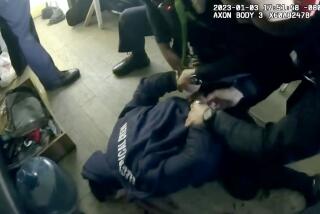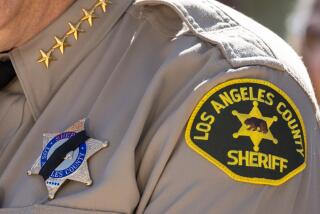Editorial: Toughen California’s rules on deadly police shootings

Police officers should use deadly force only when they have no reasonable alternative. But that easy and obvious statement necessarily raises two questions: Who is to decide whether there were alternatives and they were reasonable? And what should be the consequences for police who fail to meet the standard?
These questions are at the core of a nationwide discussion over policing and the troubling, and continuing, reports of fatal police shootings of unarmed Americans — often African American men and boys. The somber roll call includes Ezell Ford in Los Angeles in 2014 and Stephon Clark in Sacramento earlier this year. In between there have been far too many, beyond merely those whose names have become headlines: Michael Brown in Ferguson, Mo., and Laquan McDonald in Chicago in 2014. Tamir Rice in Cleveland the same year. Tony Robinson in Madison, Wis., and Walter Scott in North Charleston, S.C., in 2015. Terence Crutcher in Tulsa, Okla., Philando Castile in Minnesota and Alton Sterling in Baton Rouge, La., in 2016. Changes in police practice are frustratingly slow, and local governments have struggled to raise standards while still acknowledging the very difficult, dangerous and necessary work that law enforcement officers perform.
For the record:
12:40 p.m. Aug. 16, 2018An earlier version of this editorial referred to the death of an unarmed black man in Ferguson, Mo., named Eric Garner. It should have said Michael Brown.
After the fact, departments can fire or otherwise discipline police who were too quick to pull the trigger. But do they? In California, confidentiality laws make it virtually impossible for the public to find out. Survivors might sue those officers, but immunity laws often prevent compensation. When lawsuits do go forward, cities and counties may pay huge damage awards, which drain the treasury (and the taxpayers’ pockets) without necessarily changing the behavior of police. Activists can demand criminal prosecution of individual officers — but district attorneys seldom bring charges because laws grant police officers wide latitude in performing their duties.
Departments can fire or otherwise discipline police who were too quick to pull the trigger. But do they?
In Los Angeles County, for example, Dist. Atty. Jackie Lacey declined to file criminal charges against LAPD Officer Clifford Proctor for fatally shooting Brendon Glenn near the Venice boardwalk in 2015, though even then-Chief Charlie Beck said Glenn should be prosecuted.
Protesters have called for Lacey’s ouster over that decision and others, but at some point it’s not enough to change the officials. It’s necessary to change the law.
To that end, the Legislature is considering AB 931, a bill to tighten California’s laws on justifiable homicide and use of force by law enforcement officers. It’s a timely and appropriate measure and deserves approval.
Boiled down to its essence, police deadly force would be justified only when it is necessary to prevent imminent serious injury or death, and when there are no reasonable alternatives. What sorts of alternatives? Police would have to try to de-escalate situations, whether by moving, communicating or taking some other steps, when doing so is safe.
Enter the Fray: First takes on the news of the minute from L.A. Times Opinion »
Now, police may use deadly force in situations in which a “reasonable police officer” would do so. The problem with that standard is that it is a sort of tautology. When is it reasonable for a police officer to use deadly force? Whenever other reasonable police officers would have done the same thing. It’s a rule that slows the effect of rising standards in more forward-looking departments.
The much-criticized LAPD, incidentally, is one of those more forward-looking departments. It has incorporated into its training the importance of de-escalation. It includes in its disciplinary process consideration of whether officers’ poor decisions unnecessarily put them in a situation in which they had to fire to protect their own lives. It emphasizes preservation of human life as the top goal in dangerous police encounters. A number of other departments have done the same thing.
But those higher standards fall by the wayside when the case comes to a district attorney because neither police agencies nor the cities and counties of which they are a part can deviate from the state’s criminal laws. The bill would incorporate the higher standard of conduct into that criminal law. Officers whose gross negligence put them in a situation they had to shoot their way out of, or who shot when they could have employed nonlethal alternatives, could be charged with manslaughter. It’s closer to the standard that every other Californian has to meet. Because we call on police to do dangerous work, they would still be left with a great deal of leeway — just not quite as much as their colleagues nationwide have accorded themselves.
Follow the Opinion section on Twitter @latimesopinion and Facebook
More to Read
A cure for the common opinion
Get thought-provoking perspectives with our weekly newsletter.
You may occasionally receive promotional content from the Los Angeles Times.






